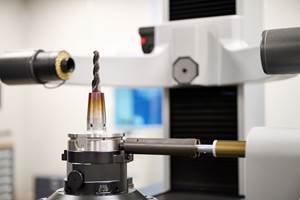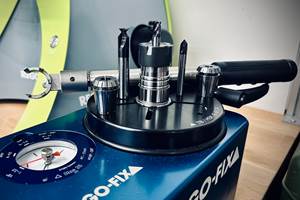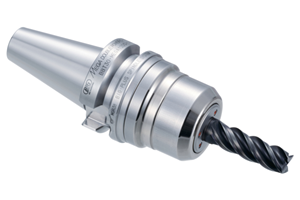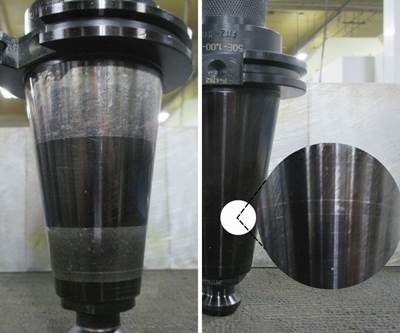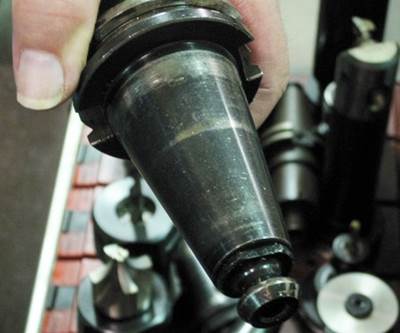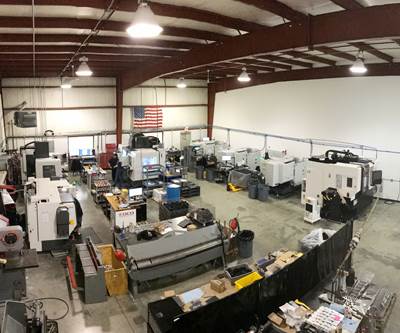High-Torque Retention Knobs Solve Aerospace Milling Production Challenge
L.H. Thomson exclusively uses high-torque retention knobs from JM Performance Products on every tool on its machines to improve heavy milling on titanium and stainless steel parts.
Share





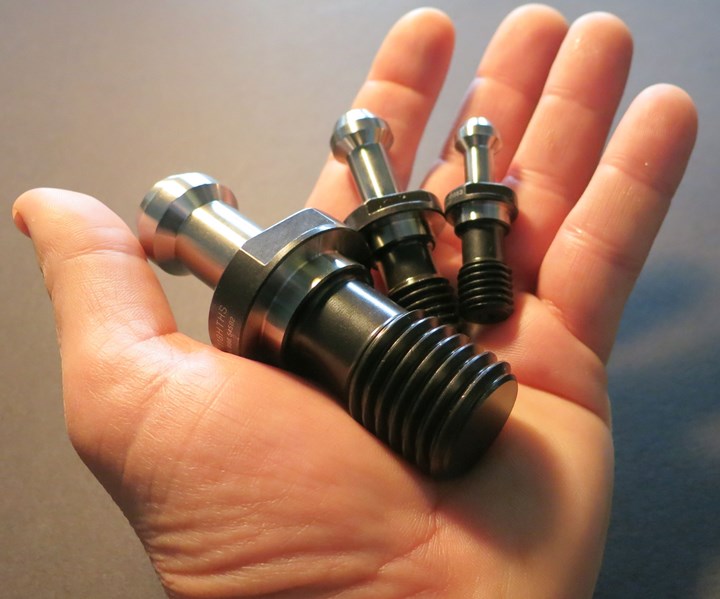
The key element of JM Performance Product’s high-torque retention knob design is that it is longer on the thread side than standard knobs. This enables it to reach deeper into the cross section of the holder’s threaded bore.
Lack of contact between a CNC machine’s spindle and toolholder, a toolholder’s lack of balance/concentricity, and improper seating within the spindle can increase cycle times and reduce material removal rates, leading to increased time for part completion.
L.H. Thomson of Macon, Georgia, progressively addressed these issues by implementing JM Performance Products’ high-torque retention knobs. By doing so, the company was able to eliminate the toolholder expansion responsible for its costly and ongoing CNC milling and boring issues.
The Challenge with High rpms
As a manufacturer of aerospace parts and assemblies since 1981, L.H. Thomson focuses on monolithic commercial aircraft components that utilize aluminum, titanium, high-temperature alloys, stainless steel, high nickel, copper, plastics and composites. Manufacturing these exotic materials creates a unique set of production machining challenges because high speeds, typically in excess of 20,000 rpm, are often required.
As L.H. Thomson experienced steady growth in the late 2000s, aerospace production at these spindle speeds began sometimes to result in critical damage to expensive workpieces on various brands of machining centers. The cause was rarely clear, except in the notable case in which a retention knob failed during a heavy milling operation on a horizontal machining center, causing the toolholder to be ejected out of the machine spindle at 12,000 rpm. This resulted in excessive damage to the spindle, toolholder, cutting tool, workpiece and machine.
The failed retention knob was sent to a metallurgist, who analyzed the microstructure failure of the material and pinpointed that the retention knob was improperly heat-treated, which caused the failure at the minor diameter of the OD thread and the coolant-through hole by hydrogen embrittlement.
In order to move toward lights-out machining and avoid increased costs per part, L.H. Thomson needed a retention knob that could improve contact with the toolholder, reduce spindle loads, and increase speeds and feeds — all while increasing the capacity to remove more cubic inches of metal per minute.
Increasing Spindle Surface Contact
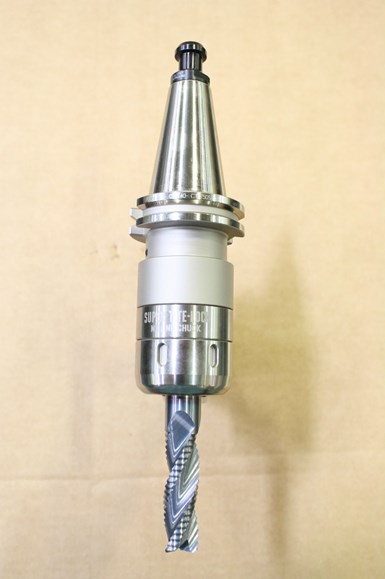
JMPP’s high-torque retention knobs are designed to improve the connection between the cutting tools and the machine spindle compared to standard retention knobs.
Now-retired R&D engineering manager Daniel Nietzold was tasked with finding retention knobs that could overcome any potential failure and toolholder ejection related to milling exotic materials at high metal removal rates. During his research, he found that CNC milling using V-flange tooling could potentially cause a standard retention knob to expand the small end of the toolholder when it is installed with as little as 20 foot-pounds of torque. With a CAT 40 toolholder, expansion could begin at just 15 foot-pounds. Of note, the extent of this expansion is variable, depending on the holder, the retention knob and the installation practice.
While attending the International Manufacturing Technology Show (IMTS), Mr. Nietzold met with John Stoneback, president of JM Performance Products (JMPP), who demonstrated his company’s high-torque retention knobs. These knobs were designed to resolve improper seating of the toolholder in the spindle. It achieves this by lengthening the knob on the thread side to enable it to reach deeper into the cross section of the holder’s threaded bore. All thread engagement occurs in a region of the toolholder where the cross section is thicker to resist deformation. Additionally, a precision pilot also increases rigidity, which increases the rigidity of the toolholder itself at higher speeds, so the knob can increase the tool life.
According to Mr. Stoneback, “By increasing contact with upward of 70% more spindle surface, a wide range of CNC milling issues are overcome including vibration and chatter, poor tolerances, non-repeatability, poor finishes, shortened tool life, excessive spindle wear and tear, runout and shallow depths of cuts.”
In-House Testing
After returning from IMTS, Mr. Nietzold tested the new knob against the standard knob. First, he torqued the standard knob, cleaned the spindle, “blued up” the toolholder, and stuck it back in the spindle. He then removed the toolholder from the spindle to see what the contact patch looked like. After that, he cleaned the toolholder and repeated the process with the JM high-torque retention knob. The results showed that the toolholders with the JM high-torque retention knobs were making much more spindle contact than the old retention knobs, which led Mr. Nietzold to move forward with extensive in-house testing.
He tested the JM retention knob’s effectiveness by running a 3-inch-diameter high-feed milling cutter in a rough milling operation on a large aerospace titanium component that was already being produced with a validated process. He immediately saw a 30% spindle load reduction. This enabled him to increase feed rates and depth of cut, bringing the spindle load back up to 100%. The end result was a major cost savings due to the increased metal removal rates, plus unexpected tool life improvements due to better connection at the spindle.
“At this point we were highly invested in our machines and top-quality tooling, but we were missing out on the connection at the spindle. Fundamentally, the flaw started at the retention knob, and the high-torque retention knobs solved the problems,” Mr. Nietzold says.
Mr. Nietzold proceeded to convert to only using JMPP’s high-torque retention knobs.
Requesting Value-Added Processes
To make certain that the puzzle was completely solved and to ensure production sustainability, L.H. Thomson requested additional value-added processes to be performed by JMPP, which included magnetic particle inspection tests and part number serialization.
The company’s old retention knobs had continually experienced hydrogen embrittlement failure at the minor diameter of the thread and the coolant-through hole, which produced cracks that could result in toolholder ejection and damage to the toolholders and machines. Hydrogen-induced cracking (HIC) refers to the internal cracks brought about by material trapped in budding hydrogen atoms. To make sure there were no HIC flaws in the new high-torque knobs, L.H. Thomson asked JMPP to conduct a magnetic particle inspection test on all purchased knobs to detect minute surface and near-surface cracks down to a depth of about 0.100 inch. Essentially, a magnetic field is induced in the test specimen, which is then “dusted” with iron particles, either dry or in a liquid suspension. The particles will collect along the edges of any micro cracks or other discontinuities in the structure of the material to provide a readily visible indication of the flaw. The testing proved out JMPP’s high-torque knobs, which showed no signs of HIC.
L.H. Thomson also requested part number serialization. Retention knobs are not intended to last forever, subjected as they are to more repetitive stress than any other parts of a mill. Therefore, they need to be inspected periodically. JMPP custom laser marks the serial and part numbers for all of the retention knobs to help keep track of their time in service for optimal usage. Routinely tracking the knobs’ service life insures against retention knob stress failure.
From L.H. Thomson’s early adoption and conversion to the high-torque retention knobs to today, the company has expanded its machining center capabilities and has installed more than 1,000 knobs.
Related Content
PowRgrip Responds to Three Tooling Trends
Rego-Fix’s PowRgrip tooling system has expanded over the past 20 years to incorporate a wider range of tool sizes, as well as automation.
Read MoreSimulation and Tooling Secure High-Value Work
Simulation software and careful attention to tooling parameters have enabled Major Tool to take on ambitious projects with its complex machinery.
Read MoreMaking the Most of Mixed Toolholder Assemblies
While nearly all ER systems will have cross compatibility, they’ll have small differences across manufacturers that make their implementation at the shop level not as standard.
Read MoreBig Daishowa Chuck Eliminates Chatter in Milling Operations
The Mega 12DS chuck is designed for trochoidal milling with anti-vibration end mills.
Read MoreRead Next
Overcoming Toolholder Deformation with High-Torque Retention Knobs
At Hansen Engineering Co., toolholder expansion reduced spindle contact, causing a variety of production issues. High-torque retention knobs from JM Performance Products increased productivity and reduced downtime.
Read MoreThe Knob Problem
The retention knob is an unmistakably critical component of the machining process. However, the tightening of the knob itself can lead to the toolholder not seating securely in the machine. You may be losing tool life to knob tightness without even knowing it.
Read MoreWith Retention Knobs, Shop Sets Sight on Aerospace Machining
Mitch and Brian Olson didn’t know much about CNC machining when they started their machine shop, but they learned that if they wanted to pursue high-accuracy aerospace work, they would need to overcome a flaw inherent in V-flange tooling.
Read More
























